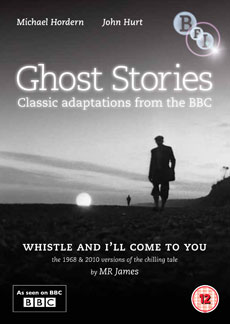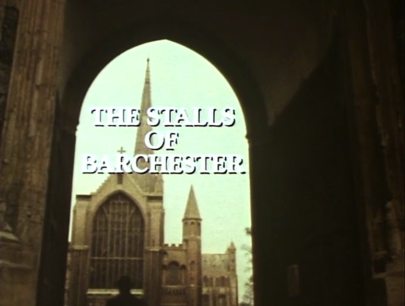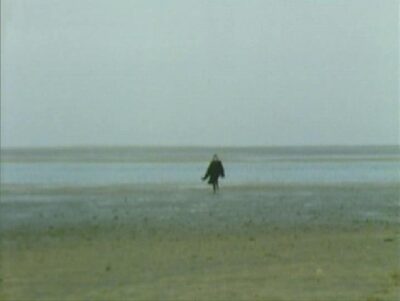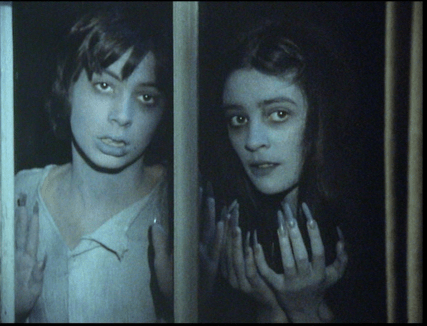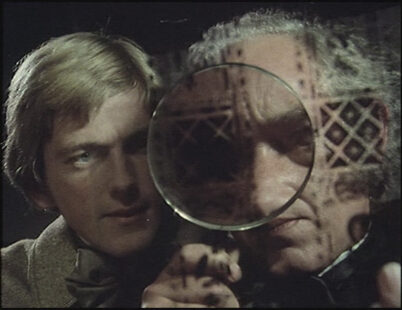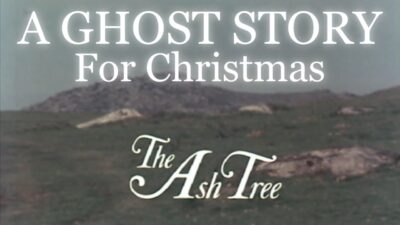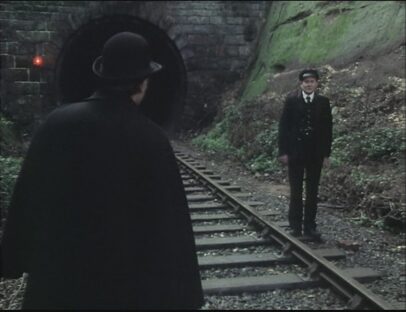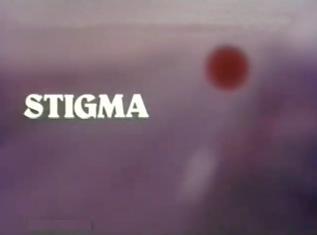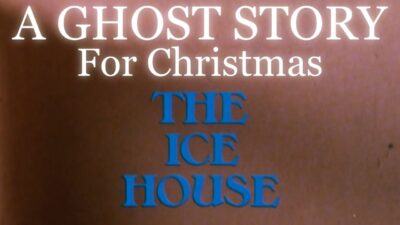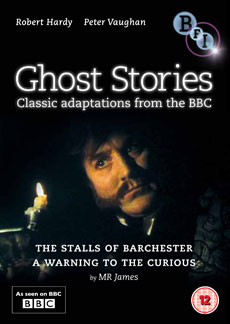 The Christmas ghost story is a British tradition that found its ideal screen capture in the BBC’s A GHOST STORY FOR CHRISTMAS (1971-78). The show was revived in 2005, but it’s the 1970s-era episodes that resonate, with their evocation of a peculiarly British-centric brand of classical horror whose refined aura was best summed up by author R. Chetwyn-Hayes: “Courage—real courage—is the ability to see horror on the far side of a crowded room and still have the presence of mind to ask for another cup of tea.”
The Christmas ghost story is a British tradition that found its ideal screen capture in the BBC’s A GHOST STORY FOR CHRISTMAS (1971-78). The show was revived in 2005, but it’s the 1970s-era episodes that resonate, with their evocation of a peculiarly British-centric brand of classical horror whose refined aura was best summed up by author R. Chetwyn-Hayes: “Courage—real courage—is the ability to see horror on the far side of a crowded room and still have the presence of mind to ask for another cup of tea.”
That brand of horror was especially well exemplified on screen by “Whistle and I’ll Come to You,” a 41 minute adaptation of M.R. James’s “Oh whistle and I’ll Come to You, My Lad” that was shown on BBC’s OMNIBUS. Christmas doesn’t figure thematically, or in its broadcast history (it aired in May 1968), but the show provided the direct inspiration for A GHOST STORY FOR CHRISTMAS, whose episodes likewise took the work of M.R. James as their primary inspiration.
Adapted and directed by Jonathan Miller, and visualized in nightmarish black and white by cinematographer Dick Bush, “Whistle and I’ll Come For You” features Michael Horden as a professor who finds a bone whistle in an overgrown cemetery, which upends his reality. The beachside setting, filmed on the Norfolk coast, proves invaluable in imparting an eerie and ominous atmosphere (as it would a decade later in Jerzy Skolimowski’s THE SHOUT), and Horden is pitch-perfect, particularly in the denouement, in which his reaction to a ghostly visitation is more affecting than what he sees.
Premiering on December 24, 1971, “The Stalls of Barchester,” adapted from M.R. James’ 1910 tale “The Stalls of Barchester Cathedral,” initiated the series proper. It’s a sumptuously mounted period piece with a fine, crisp look that would mark the rest of the series, as would the unusual-for-the-time practice of lensing the interiors and exteriors on 16mm film (as opposed to the standard seventies-era BBC practice of intermixing film and video stock), and also the presence of writer-director Lawrence Gordon Clark behind the camera, which he did on all but one of the original episodes.
The 45-minute runtime is a bit excessive, and the use of narration (something with which the subsequent episodes didn’t bother) a mite redundant, but on the whole “The Stalls of Barchester” marked an effective start to the series. Featured is a mild-mannered scholar (Clive Swift) becoming involved in a supernatural drama upon encountering a half-century old diary in the Barchester Cathedral, which is made into a character—and an extremely important one—in its own right.
“A Warning to The Curious” followed on December 24, 1972. It once again utilizes the Norfolk coastal setting of “Whistle and I’ll Come to You,” where an archeologist (Peter Vaughan) unearths an age-old crown said to protect the coast. This puts Vaughan squarely in the sights of a supernatural menace, which doesn’t abate when he reburies the crown.
This episode is notable for the addition of a shock prologue to the James text, and the manner in which Clark handles the ghostly appearances. Occurring more often than not in quick flashes, those appearances are pulled off with admirable simplicity, as in the powerfully haunting sight of a dimly glimpsed figure running toward the camera.
At just 30 minutes, the Robin Chapman scripted “Lost Hearts,” broadcast on Christmas Day, 1973, is one of the shorter episodes. It features yet another hapless individual beset by ghostly shenanigans in a rural setting, in this case an 11-year-old boy (Simon Gipps-Kent) who’s confronted with two ghost children while staying at a country mansion. The appearances of the spectral children are well handled, with particular emphasis placed on the long, and so quite deadly, fingernails the kids sport.
“The Treasure of Abbot Thomas,” from December 23, 1974, begins slowly but has a banger of a climax, in which the treasure of the title is found (it seems) in the bowels of a castle, only to have something else unearthed in the process. Scripter John Bowen altered a great deal of James’ compelling 1904 story (which for starters was set in Germany, whereas the adaptation takes place entirely in England), which I say hurts the proceedings. At least, however, the changes aren’t as severe as those wreaked on the subsequent episode.
“The Ash-Tree” is my favorite of James’ tales, so I’m predisposed to be partial to any well-made screen adaptation—and this one, broadcast on December 23, 1975, is undeniably well made. That’s a good thing, because scripter David Rudkin misses a great deal of what rendered the 1904 story so memorable.
The copious flashbacks to a witchcraft trial conducted by a distant relative of the protagonist (both characters played by Edward Petherbridge), an aristocrat who inherits an accursed country estate, dilutes the focus considerably (and the hairy spider-like critters that turn up near the end are frankly pretty silly-looking). Clark himself summed up the program’s failings quite adroitly: “I don’t think the script quite did justice to the story, and maybe someone else should have a go at it.”
“The Signalman,” broadcast in 1976, was the first GHOST STORY FOR CHRISTMAS episode based on a story by someone other than M.R. James. That someone was Charles Dickens (of A CHRISTMAS CAROL, surely the ultimate Ghost Story for Christmas), who penned this account of a train signalman in touch (he claims) with a calamity-predicting specter after surviving the June 9, 1865 Staplehurst rail crash at age 53.
“The Signalman,” scripted by Andrew Davies, is often singled out as the highlight of the series, and that judgement may well be accurate. Excellent use is made of motifs both aural and visual, the use of dream sequences to bolster the narrative works well, and the performance of Denholm Elliott as the title character is beyond reproach, making one lament that this gifted performer remains best known in the US as Coleman the butler in TRADING PLACES.
Things went awry with “Stigma,” broadcast on December 29, 1977, in which somebody made the questionable decision to update the show for “modern sensibilities.” It was such thinking that gave us the notorious current iteration of DR. WHO, and the present series was similarly impaired, with the classic ghost story source texts nixed in favor of an original treatment by Clive Exton that incorporated nudity and gore. The results aren’t bad, but they fail to compliment, much less match, what came before.
Kate Binchy plays a young woman who moves with her family into a country cottage affronted by a large prehistoric stone. The family decide to have it removed, which causes Binchy to bleed profusely through her skin; it’s eventually revealed that the stone marked the burial site of an executed witch, whose wounds were taken on by Binchy.
“The Ice House,” scripted by “The Treasure of Abbot Thomas’” John Bowen and directed by Derek Lister (Lawrence Gordon Clark having decamped to ITV), continued the ghost-free “Ghost Story” format set by the previous episode. Involving a country health spa and a flower with seemingly narcotic properties, it’s been called the “most daringly experimental” GHOST STORY FOR CHRISTMAS episode, but if so that experimentation is extremely muted, with the film fitting in best with the horticultural horror trope of 1970s low budget features like PREMONITION (1972) and THE GARDENER (1974).
“The Ice House” marked the program’s final episode. A GHOST STORY FOR CHRISTMAS was cancelled, and stayed so until 2005, when it was rebooted by the BBC (starting with an adaptation of the M.R. James tale “A View from A Hill”). The new series, unsurprisingly given that it was made with a “limited budget,” failed to recapture the excellence of what came before, despite some promising source material (such as Arthur Conan Doyle’s evil mummy classic “Lot No. 49”), and is ultimately best forgotten.

